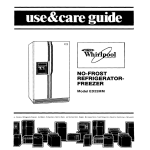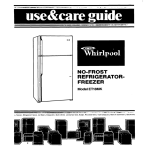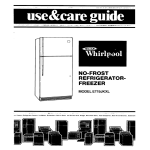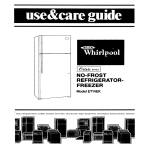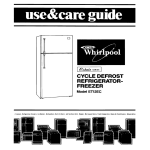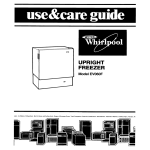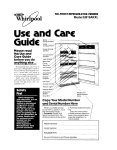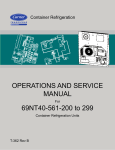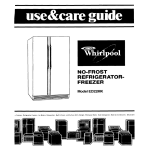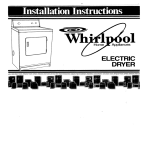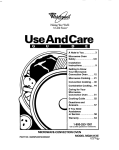Download Whirlpool ET16TK User's Manual
Transcript
NO-FROST REFRIGERATORFREEZER c Model ETIGTK trs. Freezers. Refrlgeralor-Freezers. Ice Makers. Dishwashers, Eluill-In Ovens and Surface Unlls. Ranges, Microwave Ovens, Trash Compactors. Room Au Condltloners. Oehumldlli Please read this Use and Care Guide before you do anything else... This booklet tells you how to start your refrigerator, clean it, move shelves and adjust controls. It even tells you what new sounds to expect from your refrigerator. Treat your new refrigerator with care. Use it only to do what home refrigerators are designed to do. Parts and features Shelves Model and Serial Number Copy your Model and Serial Numbers When you need service or call with a question, have this information ready: here... Model Number 1. Complete Model and Serial Numbers (from the plaie located as shown). Serial Number 2. Purchase date from sales slip, Purchase Copy this information in these spaces, Keep this book, your warranty and sales slip together in a handy place. 2 Date Service Company and Telephone Number Contents Ice Cube Trays Optional Automatic Ice Maker Sounds You May Hear. Energy Saving Tips BEFOREYOU PLUG IT IN Install Properly Level Refrigerator-Freezer Remove Sales Labels Clean It Plugltln ., ,. ,......, CLEANING YOUR REFRIGERATOR Cleaning .., ,.., USING YOUR REFRIGERATOR Setting the Controls Changing the Control Settings Power Saving Control Changing the Light Bulb Moving the Meat Pan and Cover Adjusting the Refrigerator Shelves Removing the Crispers and Cover Adjusting the Freezer Shelf *-IW^‘ ...“*.I.---Ip-.I---.-I --I_ Page 7 7 7 7 .“. .^__. _II__ FOOD STORAGE GUIDE 9 Storing Fresh Food Storing Frozen Food 9 10 VACATION AND MOVING CARE IF YOU NEED SERVICE OR ASSISTANCE I, 2. 3. 4. __...-_,“~ 01984 Whirlpool 8 8 Chart Before Calling for Assistance If You Need Assistance If You Need Service If You Have a Problem _ I- ._.~.\. -,.,. _, .- ,. ._..,. ,- 10 11 11 11 11 11 _rr.r,._-... Corporation Before you plug it in IMPORTANT Before using your refrigerator, you are personally responsible for making sure that it... l is installed and leveled on a floor that will hold the weight, and in an area suitable for its size and use. l is connected only to the right kind of outlet, with the right electric supply and grounding. l is used only for jobs expected of home refrigerators l is not near an oven, radiator or other heat source. l l l l l l is properly maintained. is out of the weather. is used in an area where the room temperature will not fall below 55” F (13” C). is not run where there are explosive fumes. is not used by children or others who may not understand how it should be used. is not loaded with food before it has time to get properly cold. Install properly.. Remove sales labels.. . . Remove the Consumer Buy Guide label and other Inside labels before usrng the refrigerator. Any glue left can be taken off with rubbing alcohol. NOTE: DO NOT REMOVE ANY PERMANENT INSTRUCTION LABELS INSIDE YOUR REFRIGERATOR. Do not remove the Tech Sheet fastened under the retrigerator at the front. -?AAlmbel SW. vz;.r’“.**.w-” s,eG..esYmx* .I.&I Ih.SxeW .ii ..s,~~.vATses-.s5 gf Clean it.. . 1. Allow 3 inches (7.5 cm) between overhead cabinets and the refrigerator top 2 Allow at least an inch (2.5cm) between the refrigerator condenser and the wall. 3. Allow % inch (1.25 cm) on each side of the refrrgerator for ease of installation. 4. If the refrigerator is to be against a wall, you might want to leave enough space so the door can be opened wider. ru-*smte Level refrigerator-freezer.. Right to Raise; left to lower Leveling screw Clean your refrigerator before rng instructions on page 8. using it. See clean- Plug it in... . II Raise I Use Screwdriver to Adjust 1 To rarse front. turn each screw to the right 2 To lower front, turn each screw to the left 3 Check with level t Refrigerator Power Cord RECOMMENDEDGROUNDING METHOD A 115 Volt, 60 Hz., AC only 15 or 20 ampere fused and properly grounded electrical supply is required. It is recommended that a separate circuit serving only this appliance be provided. Do not use an extension cord. Use a receptacle which cannot be turned off with a switch or pull chain. See individual electrical requirements and grounding ature package. 4 instruction sheet in your liter- Refrigerator .r-..<Twc,I Control . Setting / Power Saving I. _..5,_L the controls.. Control .,- . Controls for the refrigerator and freezer are in the refrigerator. When the refrigerator IS plugged in for the first time... 1. Set the REFRIGERATOR CONTROL to 3. time to cool down comfood. (This may take sev- eral hours.] These settings should be about right for normal household refrigerator usage. The controls will be set about right when milk or juice is as cold as you like and when ice cream is firm. 2. Set the FREEZER CONTROL to B. Changing Glve the refrigerator pletely before adding the control settings . . . If you need to adjust temperatures in refrigerator of freezer, use the settings listed in the chart below. l l l Adjust the Refrigerator Control first. Wait at least 24 hours between adjustments Then adjust the Freezer Control, if needed. RECOMMENDED CONDITION: If Refrigerator Section is TOO WARM If Freezer Section is TOO WARM QUESTIONS? .,,calt your COOL-LINE” service assistance telephone number (page 111. REASONS: ._.-_~-l--_l_ ---... If Refrigerator Section is _-_ ._ ...-I -“-_, . ,--___ SETTINGS: _--_._.____ Door opened often Large amount of food added too warm -..-_ --.._-.-~ Room temperature--,______---___-__IDoor opened often Large amount of food added Very cold rmrn temperature (can’t cycle often --. enough] ~-I_-Controls not set correctly for your conditions TOO COLD If ICE isn’t MADE FAST ENOUGH Heavy ice usage Very cold room temperature (can’t cycle often enough) Door opened often Large amount of food added Very warm or very cold room temperatures If BOTH SECTIONS are TOO WARM Power Saving Control.. CONTROL _I_..--_- -.._--_ Refrigerator Freezer : -..._-..I_ ..-.--“----- Refrigerator Freezer -..=--^--.-.-~-..^ Refrigerator Freezer ---___-Refrigerator Freezer Refrigerator Freezer -3 A 2 B 3 A 4 0 . The Power Saving Control on the Control Console operates electric heaters around the door openings. These heaters help keep moisture from forming on the outside of the refrigerator. I, Use the “CONSUMES LESS ENERGY” setting when humidity is low. 2 Use the “REDUCES EXTERIOR MOISTURE” setting only if moisture forms on the outside of the refrigerator. 5 Changing the light bulb... Unplug the retrlgerator tlrst. 1. Reach behind control console to find bulb 2. Remove bulb. 3. Replace with a 40-w& appliance bulb. Moving the meat pan and cover... Removing: The meat pan and cover can be removed for cleaning and moved to another shelf, If desired. Remove the meat pan first. 1. Slide the pan out to stop. 2. Lift the front of meat pan. 3. Slide pan the rest of the way out. 4. Tilt cover up at front. 5. Pull forward and out. Replacing: 1. Fit notches underneath cover over rear and center cross bars on shelf. 2. Lower cover in place. 3. Replace meat pan in reverse order. Adjusting the refrigerator shelves... 1 Ftrst, remove food from shelf. 2. Slide shelf straight out to stop. 3. Lift front. 4. Slide the rest of the way out Replacing Guide Star Shelf Stop Shelf: 1. Fit back of shelf on top of guides with wire stops on the bottom of guides. 2. Lift front, slide shelf In until it clears gurde stops 8. ,. Shelf Guide . . ..~ .- Removing crisp&s aid crisper cover.. . Removing the Crispers: Lift the Front, Then the Back. 1. Slide crisper straight out to stop, lift front, then slide the rest of the way out. 2. Replace in the reverse order Removing Cover: 1 Lift front and remove the cover support 2. Lift out cover by pulling up and out. Replacing Cover: 1. Fit back of cover into notch supports on walls of refrigerator, then lower front into place. 2. Replace cover support with the long tab towards the front. Note: If support needs adjustment, turn base right to lower, or left to raise. To remove shelf: I, Lift front slightly. 2. Lift back off supports. 3. Replace in reverse order. To adjust shelf: 1. Remove shelf. 2. Remove supports by sliding upwards. 3. Replace supports on desired level. 4. Replace shelf. 6 Shelf Support Pull out to stop. ront and Pull Again. If cubes are not used, they may shrink. The moving cold arr starts a slow evaporatron. The longer cubes are stored, the smaller they get. Ice cube trays.. . To remove Ice: 1. Hold tray at both ends. 2. Slightly twist. b=+mLr.-n *,m.I UI~~~lr Lmic’ Optional ~.ri?,T~.,s,uaIY~~..~-,- automatic ice maker. . . n lower Slgnal Arm to Start It. dalse Signal Arm to Stop Ice Maker. If you have the automatic ice maker accessory or plan to add one later (Part No. ECKMF-83). there are a few things you will want to know: l The ON/OFF lever is a wire signal arm. Down...for making ice automatically; Up...toshut off the ice maker. l Shake the bin occasionally to keep cubes separated, and to obtain increased storage capacity. .I_~.; r ,**./, .U.<,>’_ - .G 1c .r.- :‘rclcm-m-x vuu.-- It is normal for ice crescents to be attached by a corner. They will break apart easily. l You will hear water running when ice maker is working. You’ll hear ice fall into the bin. Don’t let these sounds bother you. l The ice maker will not operate until the freezer is cold enough to make ice. This can take overnight. l Because of new plumbing connections, the frrst ice may be discolored or off-flavored. Discard the first few batches of ice. l If ice is not being made fast enough and more ice is needed, turn the Refrigerator Control toward a higher number. Wait a day and, if necessary, turn the Freezer Control toward A. l If you remove the ice bin, raise the signal arm to shut off the ice maker. When vou return the brn. push it all the way in and lower’the arm to the ON positron. l If cubes are stored too long, they may develop an off-flavor...like stale water. Throw them away. They will be replaced. Cubes in the ice bin can also become smaller by evaporation .%-.l*r*ndUNU.~\F,e4sj<.P-: ..v-,am F., I.nl*l_i.,.o. l Your new refrigerator may make sounds that your old one didn’t. Because the sounds are new to you, you might be concerned about them. Don’t be. Most of the new sounds are normal. Hard surfaces like the floor, walls and cabinets can make the sounds seem louder. The following chart describes the kinds of sounds that might be new to you, and what may be making them. . j .~ _ ._ ^ Posslbli S&n&: - Probable .-, Causes: Slight. Hum, Soft Hiss: Clicking or Snapping Sounds: l l l l l ., Your refrigerator has a fan; you may hear the fan motor and moving air. The defrost timer makes a definite click when the refrigerator stops running. It also makes a sound when the refrigerator starts. - ..__ Water Sounds: When the refrigerator stops running, you may hear gurgling in the tubing for a few minutes after it stops. You may also hear defrost water running into the defrost water pan. ~-_ ,._ ,. -- .--._ --.-_ .___ -1 --.-“-, . ..--._. _-.__-._-__ -r- ._“..., .-. __” .-,,_..- -~ ._... ,_” _._... .._“_-_“- ,_^. If your refrigerator has an ice maker, you may hear buzzing [from the water Ice Maker Sounds: valve), trickling water and the clatter of ice dumped into the bin. -trickling water -thud (clatter of ice) __.._.-~--“--_--__ --. .--_ -_-_-..-_-._ _, ., _.--.. __I._“._.,__ _...__ .-... Running . . Sounds: . - _ _ Your refrigerator has a high-efficiency compressor and motor. It will run longer than older designs. It may even seem to run.._.. most the .._ time. ,, -__.of -._ ...lIC_I _---,.--.-. . ., _ -._ ._ ,.,___ _.__._. . . _, ..-_._ Energy saving tips.. . You can help your refrigerator use less electricity. Check door gaskets for a tight seal. Level the cabinet to be sure of a good seal. l Clean the condenser coil regularly. l Open the door as few times as possible. Think about what you need before you open the door. Get everything out at one time. Keep foods organized so you won’t have to search for what you want. Close door as soon as food is removed. l Go ahead and fill up the refrigerator, but don’t overcrowd it so air movement is blocked. l It is a waste of electricity to set the refrigerator and freezer to temperatures colder than they need to be. If ice cream is firm in the freezer and drinks are as cold as your family likes them, that’s cold enough. l Keep the Power Saving Control on CONSUMES LESS ENERGY unless moisture forms on refrigerator exterior. l Make sure your refrigerator is not next to a heat source such as a range, water heater, furnace, radiator, or in direct sunlight. .-.,rr .v,gUXII..+r.-f~~~,-. :i(i.* r,*.Pl~,11( L*r-3-a 7 l Cleaning your refrigerator To clean your refrigerator, turn the Refrigerator Both the refrigerator and freezer sections defrost Control to OFF, unplug it, take out all removable automatically. But both should be cleaned about parts, and clean it according to the followrng once a month to help prevent odors from building directions. up. Of course, spills should be wiped up right away. 1nr* P.,r.“<-,Cv .I n,i~liG.e,-~..;~, *,/ ...“. ..I.W#.“Sibl >.wn-&s~/.*.l..~ .IY.7A. -1. I I.. :I‘.. . .._ *&z+~wlill~~c.cr.1*,Lm oT.slren., Cleaning chart... . Part -__.. -.. .. .I __..._..~._. .___,_.__ What _. to .,_ use ._._I Removable parts (shelves, crisper, meat pan etc.) Outside How to clean Wash removable parts with warm water and a mild detergent l Rinse and dry -..-.,_----. _..- .__..-.-- ., _..... _- ..__ l Wash with warm water and a mild deSponge, cloth or paper towel; mild detergent, tergent. Do not use abrasive or harsh cleansers. appliance wax (or good auto paste wax) l Rinse and dry l Wax painted metal surfaces at least twice a year with appliance wax or a good auto paste wax. Apply wax with a clean, soft cloth. Do not use wax Mild detergent warm water and l on plastic parts. Waxing painted _I . --_-.-.~. _I._---_ ._.- I--~--. Inside walls (Freezer should be allowed to warm up so cloth won’t stick.) _--._._.-__I_^_.._. Door liners and gaskets ----------~..---_----lllDark plastics [covers and panels] metal surfaces provides rust protection. ._._._~_-“-.--_ 1----------1,1 _.-_---_-- Wash with warm water and -mild detergent or -baking soda (2 tablespoons (26 g] to 1 quart I .95 I] warm water l Rinse and dry _,..-. -“_ .-.I_. I ,~ -...~__“._I I .,. .__--.-.__ - .,-. - - _.I.. ., 1,, -. . l Wash with mild detergent and warm Sponge, soft cloth or water paper towel; mild l Rinse and dry detergent, warm water Sponge. soft cloth or paper towel, baking soda, warm water, mrld detergent l DO NOT USECleaning waxes, concentrated detergents, bleaches or cleansers containing petroleum on plastic parts. Mild detergent and warm water; soft, clean sponge and soft. clean cloth. l l Wash with a soft grit-free cloth or sponge. Rinse and dry with a damp grit-free cloth or chamois DO NOT USE paper towels, window sprays, scouring cleansers, or flammable or toxic solvents like acetone, gasoline, carbon tetrachloride, etc. These can scmtch or damage the material. Defrost pan (behind refrigerator on top of the motor) Sponge, cloth or paper towel; warm water and mild detergent. l l Do not remove defrost pan to clean. l l Condenser coils Use vacuum cleaner with brush attachment. l l Floor under refrigerator Usual floor cleaners. Roll refrigerator out away from wall. Wash defrost pan with warm water and mild detergent. Rinse and dry Roll refrigerator back into place. Clean dust and lint from condenser coils behind the refrigerator at least once every other month. Leave an inch (2.54 cm] between wall and condenser coils on bock of the refrigerator. Roll refrigerator out away from wall . Wash floor l Roll refrigerator back into place. l Check to see if the refrigerator is level. l Food storage guide STORING FRESH FOOD There IS a rrght way to package and store refrrgerated or frozen foods To keep foods fresher, longer, take the trme to study these recommended steps Remove store wrapping Trim Leafy Vegetables or tear off bruised and drscolored areas Wash In cool water, drain and store in crrsper Cold, moist atr helps keep leafy vegetables fresh and crtsp with Skins (carrots, peppers) Store plastic bogs or plastic contolner Fruits Wash, let dry and store In refrigerator in plostrc bags or crisper Do not wash or hull berries untrl they are ready to use Sort and keep berries irl their store container In a crisper. or store In a looselv closed paper bag on a refrigerator shelf Cured or Smoked Meat and Cold Cuts. Ham. bacon, sausage, cold cuts, etc keep best in origlnal wropprngs Once opened, tightly re-wrap in plastic wrap or aluminum foil Canned Ham. Store in refrigerator unless the lobel soys it’s okay to store on the shelf Do not freeze Fresh Poultry Loosely ‘wrap In ‘waxed Paper or Plas+lc wrap The piastlc tiroro or Poultrv, as Pur chased, may be used for storoge STORAGECHART FOR FRESHAND CUREDMEAT* Approxlmate Time We Ways1 Vari6ty Meats . . . 1 to 2 Chicken .. . . . . . . . . . . 1 to2 1 to 2 Ground Beef . . . . .. Steaks and Roasts . . . . . . . . 3 to 5 Cured Meats . . . . .... . . . . 7 to 10 Bacon . . . . . . . . . . . . . . . . . . . . . . . . . . . . 5to7 ColdCuts . . . . . . . . . . . . . . . . . . . . . . . . 3to5 *If meat is to be stored longer than the times given, follow the directions for freezing. Vegetables in crrsper, NOTE: Fresh fish and same day shellfish should be used the OS purchased Store wrthcut washrng tn the cfrginal Eggs carton or use the egg nest in the door of your refrrgerator Milk Wipe rmik cartons For best storage place you Meat IS perrshable and expensive Meat. ml/k on rritertor stNf won’t want to waste an ounce of It through careless Beverages Wipe bo+tles and cans Store on o hondlrng The followrng lrst and chart give you packdoor shelf or Inside the refrigerator aging hunts and trme llmrts Store meat In the meat Butter Keep opened butter in covered dish cr In wn the Butter Comportmer? When storing on extra sup Fresh, Prepackaged Meat. Store fresh meat lr p’y, wrap In freezer PackagIng and freeze the store wrapping Vacuum packaged meat car Store in the orlgrnal wrapping untrl Cheese be trozen for as long as one month If the seal IS not you are ready to use it Once opened, re-wrap broken tf you want to keep It frozen longer, you tightly In ptastrc wrap or aluminum foil should wrap It with specral freezer wropplng material Store small Jars and bottles (catCondlments Fresh Meat, Not Prepackaged. Remove the sup, mustard, jelly, olrves) on the door shelves where market wrapping paper and re-wrap loosely In they are rn easy reach waxed paper or aluminum foil for storing It unfrozen leftovers Cover leftovers with plastic wrap or Cooked Meat. Wrap or cover cooked meat with aluI*llnum foil to keep food from drying out and waxed Paper. Ptastrc wrap or atumlnum foil Store trar,sferrrng food odors Plastic containers witi: trght immedlotely lids are fine, too STORING FROZEN FOOD The freezer section IS designed for storage of commerclclly frozen foods and for freezlng foods at home Store on freezer door Packaged Frozen Food shelf or In the freezer If you plan to store it for o long time, re-wrap it with aluminum foil or plostlc wrap. The following hints WI/I help Frozen Meats. keep the quality In your frozen meats 1. Freeze meat while fresh and in top condltlon 2. Use only recommended wrapping materlois 3. Prepare the meat for freezing before wrapping It Trim off excess fat and remove bones when proctlcal Meat should not be salted because salt shortens freezer life 4. Wrap tightly, pressing out as much air as possible 5. Label and dote It 6. Refreezing thawed meat IS not recommended Frozen Soups, Store Juices on freezer door shelf or in the freezer STORAGECHARTFOR FROZENFOOD Packaging -The secret of successful freezlng IS in the packaging The wrap you use must be atr. moisture and vapor proof The way you close and seal the package must not allow air, moisture or vapors in or out. Rigld polyethylene (plostlc) containers with tightfitting lids, straight-sided canning freezing jars, heavy-duty aluminum foil, plastic-coated paper and non-permeable plastic wraps [such as Saran) are recommended Note Heat-sealed bolllng bags are easy to use and can be used by themselves or as carton liners IMPORTANT: Do not expect your freezer to quickfreeze any large quantlty of food. Leave enough space for air to circulate around packages. Be careful to leave enough room at the front so the door can close tightly. Store In the freezer Once the pockIce Cream age IS opened, place 0 piece of aluminum foil or waxed paper smoothly agolnst the Ice cream surf face This WIII prevent Ice crystals frorn forrrllng Storage times given in this chart are only a guide. For best use of freezer space, keep frozen foods for short times. Use, then replace as needed. 2 months Bread .......................... 2-3 months Cooked Dishes ............... Fish and Seafoods 6months Fresh ......................... l-3 months Commercially Frozen ...... 6months Fruits ........................... 1 month Ice Cream ....................... 4-6 months Concentrated Juice .......... Meats Less than 1 month Bacon ................ 3-4 months Pork roasts, chops .......... 1-2 months Sausage .................... 6 months Beef, veal, lamb roasts ....... .I-2 months Ground meat ............... 3-4 months Poultry ..................... .................... 6months Vegetables ‘Courtesy andUSDA of Nat~onol Love Stock and Meal Board Vacation and moving care Short vacations. No need to shut away for less than freeze other Items with on aulomatlc the water supply to .. off the refrigerator If you ~111 be four weeks Use up perishables If your refrlgerotor IS equipped Ice maker, 1) turn it otf 2) shut off the ice maker, 3) empty the Ice the Ice maker at least a day ahead When the last load of Ice drops, turn off the ice maker Unplug the refrigerator and clean It rinse well and dry Tape rubber or wood blocks to both doors keeping them open far enough for olr to get In This will keep odor and mold from buildlng up h,n Y,, Long vacations. .. Remove all the food If you ore going for a month or more If your refrigerator is equipped with an automatic ice maker, turn off the water supply to 10 Tape the blocks out of a child’s reach...do not allow children near the refrigerator when the doors are blocked open. To restart refrigerator, see Using Your Refrlgerotor Moving. .. If your refrigerator is equipped with an automatic ice maker, shut off the ice maker water supply a day ahead of time. Disconnect the water line. After the last supply of ice drops, lift the signal arm to turn off the ice maker. Remove all food. Pack frozen foods in dry ice. Unplug the refrigerator and clean it thoroughly. If you need service or assistance, we suggest you follow these four steps: I. Before calling for assistance.. . Performance problems often result from little things you can find and fix yourself without tools of any kind. if your refrigerator will not operate: Is the electric cord plugged in? Is a fuse blown or a circuit breaker tripped? Is the Refrrgerator Control turned ON7 l l l if there is a rattling unfamiliar sounds: l l or jingling noise, or other Is something on top or behind the refrigerator making noise when the refrigerator is running? New features on your new refrigerator make new sounds. You may be hearing air flowing from the fans, timer clicks for the defrosting cycle, defrost water draining into the defrost pan. if there is water in the defrost pan: l In hot, muggy weather, this is normal. The pan can even be half full. Make sure the refrigerator IS level so the pan doesn’t overflow. if the ilght doesn’t work: l Check fuses and circuit plugged in. breakers. Make sure It’s See instructions for changing 6. Use appliance bulbs only. light bulbs on page it the motor seems to run too long: l l l Is the condenser, behind the refrigerator, free of dust and lint? On hot days, or if the room is warm, the motor naturally runs longer If the door has been opened a lot, the motor will run longer to cool down the interior. Remember: Motor running time depends on different things: number of door openings, amount of food stored, temperature of the room, setting of the controls. And. your new refrigerator may be larger than your old one so it has more space to be cooled. It also has a regular freezer instead of a frozen food compartment. All this means better refrigeration and may require more running time than your old one. 0 FSP Q 2. If you need assistance”‘. FSPIS o regIstered trademark of WhIrlpool COrpOrailOn for CjuolltV potiS Look for this symbol of quollty whenever you need o replacement pati for your Whirlpool oppllance FSP replacement parts WIII hi rlghl ond work rlghi because they ore mode to the some exacting speclflcotlons used to buld every new WhIrlpool appl~once .. Call Whirlpool COOL-LINE” service assistance telephone number. Dial free from: Continental U.S. . . . . . . . . . . . . (800) 253-1301 Michigan . . . . . . . . . . . . . . . . . . . (800) 632-2243 Alaska 6 Hawaii . . . . . . . . . . . (800) 253-1121 and talk with one of our trained Consultants The Consultant can Instruct you in how to obtain satisfactory operation from your appliance or, if service is necessary. recommend a quaIlfled service company in your area. 3. If you need service”‘... Whirlpool has a nationwide network of franchised TECH-CARE * Service Companies. TECH-CARE service technicians are trained to fulfill the product warranty and provide after-warranty service, anywhere in the Unlted I States To locate TECH-CARE service in your area, call our COOL-LINE service assistance telephone number (see Step 2) or look in yourtelephone directory Yellow Pages under: APPLIANCES-HOUSEHOLDMAJORSERVICE (L REPAIR if a bulb is burned out: l Remove everything that comes out. Wrap all parts well and tape them together so they don’t shift and rattle. Screw in the leveling rollers; tape the doors shut; tape the electric cord to the cabinet. When you get to your new home, put everythIng back, level it. reconnect the water supply and refer to the “Before Using., ,” page. ELECTRICAL APPLIANCESMAJORREPAIRING a PARTS OR WHIRLPOOL APPLIANCES FRANCH~SEO TECH-CARE SERVICE WHIRLPOOL APPLIANCES FRANCHISED TECH-CARE SERVICE .SERVIC ‘3’ (‘0 M,?4 X’,E.Li XYZ SERVICE CO 123 Maple 999.9999 SERI’IC‘E XYZ SERVICE CO 123 Maple. (‘0 VP4 .VlES 999 9999 OR WASHING MACHINES. DRYERS 8 IRONERSSERVICING WHIRLPOOL APPLIANCES FRANCHISED TECH-CARE SERVICE .S;ER\7( XYZ SERVICE CO 123 Maple ‘E C‘0 VP.4 VIE.5 999.9999 4. If you have a problem”. .. Call our COOL-LINE service assistance telephone number [see Step 2) and talk with one of our Consultants, or if you prefer, write to: Mr. Robert F.Gunts, Vice President Whirlpool Corporation Administrative Center 2000 US-33 North Benton Harbor, Ml 49022 If you must call or write, please provide: model number, serial number, date of purchase, and a complete description of the problem, This information is needed in order to better respond to your request for assistance. 11 Making your world a little easier. Part No. 946413 Rev. A 01984 Whirlpool Corporation Printed in U.S.A. in. ce Makers, Dtshwashers, Bwll-In Ovens and Surlace Units, Ranges, Mlcrawave Ovens. Trash Compactors. Room Au Conditioners, Dehumidifiers, Automatic Washers, Clothes Dry












